
A shoe is an item of footwear intended to protect and comfort the human foot. Though the human foot can adapt to varied terrains and climate conditions, it is vulnerable, and shoes provide protection. Form was originally tied to function, but over time, shoes also became fashion items. Some shoes are worn as safety equipment, such as steel-toe boots, which are required footwear at industrial worksites.

Footwear refers to garments worn on the feet, which typically serve the purpose of protection against adversities of the environment such as wear from rough ground; stability on slippery ground; and temperature.

The toga, a distinctive garment of ancient Rome, was a roughly semicircular cloth, between 12 and 20 feet in length, draped over the shoulders and around the body. It was usually woven from white wool, and was worn over a tunic. In Roman historical tradition, it is said to have been the favored dress of Romulus, Rome's founder; it was also thought to have originally been worn by both sexes, and by the citizen-military. As Roman women gradually adopted the stola, the toga was recognized as formal wear for male Roman citizens. Women found guilty of adultery and women engaged in prostitution might have provided the main exceptions to this rule.

A boot is a type of footwear. Most boots mainly cover the foot and the ankle, while some also cover some part of the lower calf. Some boots extend up the leg, sometimes as far as the knee or even the hip. Most boots have a heel that is clearly distinguishable from the rest of the sole, even if the two are made of one piece. Traditionally made of leather or rubber, modern boots are made from a variety of materials.
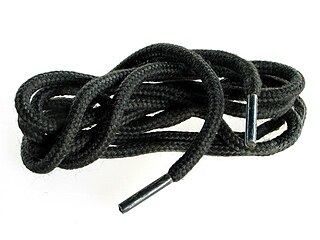
Shoelaces, also called shoestrings or bootlaces, are a system commonly used to secure shoes, boots, and other footwear. They typically consist of a pair of strings or cords, one for each shoe, finished off at both ends with stiff sections, known as aglets. Each shoelace typically passes through a series of holes, eyelets, loops or hooks on either side of the shoe. Loosening the lacing allows the shoe to open wide enough for the foot to be inserted or removed. Tightening the lacing and tying off the ends secures the foot firmly within the shoe. The laces can be tied in different shapes, most commonly a simple bow.

Sandals are an open type of shoe, consisting of a sole held to the wearer's foot by straps going over the instep and around the ankle. Sandals can also have a heel. While the distinction between sandals and other types of footwear can sometimes be blurry, the common understanding is that a sandal leaves all or most of the foot exposed. People may choose to wear sandals for several reasons, among them comfort in warm weather, economy, and as a fashion choice. Usually, people wear sandals in warmer climates or during warmer parts of the year in order to keep their feet cool and dry. The risk of developing athlete's foot is lower than with enclosed shoes, and the wearing of sandals may be part of the treatment regimen for such an infection.

Mule is a style of shoe that has no back or constraint around the foot's heel. Mules have a history going back to Ancient Rome but were not popularly worn until sixteenth-century Europe. There, mules were bedroom slippers and not worn in public. Through the centuries, mules have changed in style and purpose and are no longer just boudoir shoes but are worn at any time, for any occasion. In addition to Western examples, mules come from cultures such as Turkey and Egypt, and appear in popular culture, from famous paintings to iconic celebrities' shoes.

Combat boots are military boots designed to be worn by soldiers during combat or combat training, as opposed to during parades and other ceremonial duties. Modern combat boots are designed to provide a combination of grip, ankle stability, and foot protection suitable for a rugged environment. They are traditionally made of hardened and sometimes waterproofed leather. Today, many combat boots incorporate technologies originating in civilian hiking boots, such as Gore-Tex nylon side panels, which improve ventilation and comfort. They are also often specialized for certain climates and conditions, such as jungle boots, desert boots, and cold weather boots as well as specific uses, such as tanker boots and jump boots.
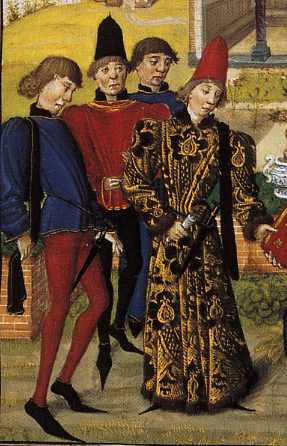
Poulaines, also known by other names, were a style of unisex footwear with extremely long toes that were fashionable in Europe at various times in the Middle Ages. The poulaine proper was a shoe or boot of soft material whose elongated toe frequently required filling to maintain its shape. The chief vogue for poulaines spread across Europe from medieval Poland in the mid-14th century and spread across Europe, reaching upper-class England with the 1382 marriage of Richard II to Anne of Bohemia and remaining popular through most of the 15th century. Sturdier forms were used as overshoes and the sabatons of the era's armor were often done in poulaine style. Poulaines were periodically condemned by Christian writers of the time as demonic or vain. Kings of the era variously taxed them as luxuries, restricted their use to the nobility, or outright banned them. After becoming more common as women's footwear and expanding to awkward lengths, poulaines fell from fashion in the 1480s and were seldom revived, although they are considered an influence on some later trends such as the 1950s British winklepicker boots.

Byzantine dress changed considerably over the thousand years of the Empire, but was essentially conservative. Popularly, Byzantine dress remained attached to its classical Greek roots with most changes and different styles being evidenced in the upper strata of Byzantine society always with a touch of the Hellenic environment. The Byzantines liked colour and pattern, and made and exported very richly patterned cloth, especially Byzantine silk, woven and embroidered for the upper classes, and resist-dyed and printed for the lower. A different border or trimming round the edges was very common, and many single stripes down the body or around the upper arm are seen, often denoting class or rank. Taste for the middle and upper classes followed the latest fashions at the Imperial Court.

A jackboot is a military boot such as the cavalry jackboot or the hobnailed jackboot. The hobnailed jackboot has a different design and function from the former type. It is a combat boot designed for marching. It rises to mid-calf or higher without laces and sometimes has a leather sole with hobnails. Jackboots have been associated popularly with totalitarianism, since they were worn by German military and paramilitary forces in the run-up to and during the Second World War. However they have been used officially by other nations as well, including the United Kingdom, and had some civilian uses.

A dress shoe is a shoe to be worn at smart casual or more formal events. A dress shoe is typically contrasted to an athletic shoe.
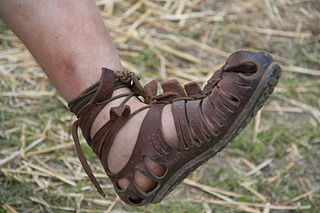
Caligae are heavy-soled hobnailed military sandal-boots that were worn as standard issue by Roman legionary foot-soldiers and auxiliaries, including cavalry.

Clothing in ancient Rome generally comprised a short-sleeved or sleeveless, knee-length tunic for men and boys, and a longer, usually sleeved tunic for women and girls. On formal occasions, adult male citizens could wear a woolen toga, draped over their tunic, and married citizen women wore a woolen mantle, known as a palla, over a stola, a simple, long-sleeved, voluminous garment that modestly hung to cover the feet. Clothing, footwear and accoutrements identified gender, status, rank and social class. This was especially apparent in the distinctive, privileged official dress of magistrates, priesthoods and the military.
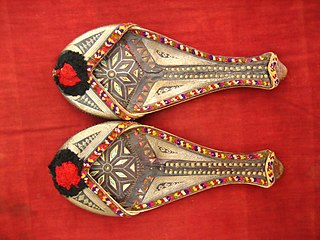
Sindhi Mojari is a type of handcrafted footwear produced in the Indian subcontinent. They are traditionally made by artisans mostly using tanned leather. The uppers are made of one piece of leather or textile embroidered and embellished with brass nails, cowry shells, mirrors, bells and ceramic beads. The bonding from the upper to the sole is done by cotton thread that is eco-friendly and enmeshes the leather fibers to strengthen the bonds. Some product range also uses bright and ornate threads.

Clothing in ancient Greece refers to clothing starting from the Aegean bronze age to the Hellenistic period. Clothing in ancient Greece included a wide variety of styles but primarily consisted of the chiton, peplos, himation, and chlamys. Ancient Greek civilians typically wore two pieces of clothing draped about the body: an undergarment and a cloak. The people of ancient Greece had many factors that determined what they wore and when they wore it.
Calceology is the study of footwear, especially historical footwear whether as archaeology, shoe fashion history, or otherwise. It is not yet formally recognized as a field of research. Calceology comprises the examination, registration, research and conservation of leather shoe fragments. A wider definition includes the general study of the ancient footwear, its social and cultural history, technical aspects of pre-industrial shoemaking and associated leather trades, as well as reconstruction of archaeological footwear.
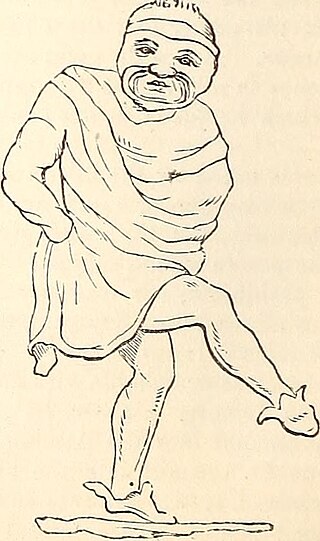
A soccus or sýkkhos, sometimes given in translation as a slipper, was a loosely fitting slip-on shoe in Ancient Greece and Rome with a leather sole and separate leather, bound without the use of hobnails. The word appears to originate from the languages of ancient Anatolia. They were worn by Ancient Greek comedic actors, contrasted with the cothurni worn by tragedians, and were borrowed into Latin and worn by the ancient Romans. The soccus was considered effeminate, and the emperor Caligula is described as having worn them, possibly as a form of insult. Later socci became popular with the general public, and several types were listed in the Edict of Diocletian. The word was adopted into West Germanic languages for similarly light footwear, eventually becoming English socks.

The carbatina was a kind of shoe common among the rural poor of ancient Greece and Rome from remote antiquity to around the 3rd century, consisting of a piece of rawhide pulled around the foot and then tied down to hold it in place. Having no upper or separate sole, the carbatina is among the simplest forms of footwear in the world and is sometimes used as a general name for similar footwear in other cultures.





















